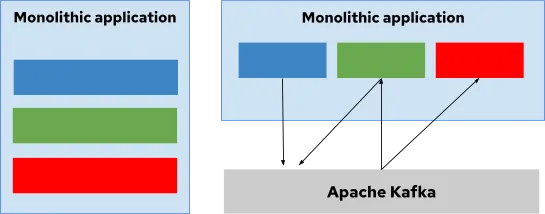Application modernization is the process of taking existing legacy applications and systems and refactoring them to drive faster time to market and to improve application performance and scalability. There are multiple modernization strategies for changing the application, but the one you select depends on your organization’s need for change. Each strategy requires different levels of involvement from the IT team and access to a modern application development platform that can provide a variety of modern tools, technologies and frameworks.
Most of the modernization efforts today are centered around migrating monolithic applications to cloud-native microservices applications that can support open collaboration between IT teams and automated application deployment and life-cycle management. Modern application development platforms, like Red Hat OpenShift, were designed to deliver a more consistent experience for building, deploying and running applications across the hybrid cloud. However, other technologies and application services are needed to facilitate the development process. This goes over a few considerations to keep in mind when modernizing applications.
Application modernization and microservices communication
With the rise of microservices and the success of many organizations implementing new applications, application modernization has taken a different direction requiring a methodical approach for transforming existing applications to a more modular and granular approach.
One method is to decompose monolith applications into independent, loosely connected microservices using a defined communication layer. This communication layer could be based on HTTP, messaging or event-driven communication. Organizations could also choose to use all three of them depending on the different business requirements.
Apache Kafka has become one of the options when looking at message driven communication between microservices. Apache Kafka is a distributed streams processing platform that uses the publish/subscribe method to move data between microservices, cloud-native or traditional applications and other systems. This technology differentiates itself from others by its ability to send and receive messages at a very fast rate, horizontally scale as the number of requests increases and retain the data even after messages have been received.
For microservices communication, Apache Kafka provides a scalable and reliable method for communication that allows you to support scenarios where large amounts of data need to be moved from multiple data sources to microservices, or in cases where near-real-time delivery of messages is required. It also allows for keeping microservices loosely decoupled and decentralized and allowing for asynchronous communication due to its broker architecture.

Apache Kafka is not only good for connecting legacy applications with other systems, but also allows for building and creating of new applications faster since developers can reuse streaming pipelines to communicate between microservices. This technology allows you to respond to modern requirements around digital experiences and streaming data.
About Red Hat OpenShift Streams for Apache Kafka
Red Hat has recently made available a fully managed Kafka service designed for IT development teams that want to incorporate streaming data into applications to deliver real-time experience and improve application velocity. Red Hat OpenShift Streams for Apache Kafka allows developer teams to keep the communication between microservices loosely coupled.
Red Hat OpenShift Streams for Apache Kafka provides a streamlined developer experience for building, deploying and scaling real-time applications in hybrid cloud environments. The combination of seamless operations allows teams to focus on core competencies, accelerate application velocity and reduce operational cost.
We invite you to read more about this by visiting the Red Hat OpenShift Streams for Apache Kafka page to learn more. You can also learn more about application modernization and microservices communication in the "Understanding Kafka in the Enterprise" webinar series.
저자 소개
Jennifer Vargas is a marketer — with previous experience in consulting and sales — who enjoys solving business and technical challenges that seem disconnected at first. In the last five years, she has been working in Red Hat as a product marketing manager supporting the launch of a new set of cloud services. Her areas of expertise are AI/ML, IoT, Integration and Mobile Solutions.
채널별 검색
오토메이션
기술, 팀, 인프라를 위한 IT 자동화 최신 동향
인공지능
고객이 어디서나 AI 워크로드를 실행할 수 있도록 지원하는 플랫폼 업데이트
오픈 하이브리드 클라우드
하이브리드 클라우드로 더욱 유연한 미래를 구축하는 방법을 알아보세요
보안
환경과 기술 전반에 걸쳐 리스크를 감소하는 방법에 대한 최신 정보
엣지 컴퓨팅
엣지에서의 운영을 단순화하는 플랫폼 업데이트
인프라
세계적으로 인정받은 기업용 Linux 플랫폼에 대한 최신 정보
애플리케이션
복잡한 애플리케이션에 대한 솔루션 더 보기
오리지널 쇼
엔터프라이즈 기술 분야의 제작자와 리더가 전하는 흥미로운 스토리
제품
- Red Hat Enterprise Linux
- Red Hat OpenShift Enterprise
- Red Hat Ansible Automation Platform
- 클라우드 서비스
- 모든 제품 보기
툴
체험, 구매 & 영업
커뮤니케이션
Red Hat 소개
Red Hat은 Linux, 클라우드, 컨테이너, 쿠버네티스 등을 포함한 글로벌 엔터프라이즈 오픈소스 솔루션 공급업체입니다. Red Hat은 코어 데이터센터에서 네트워크 엣지에 이르기까지 다양한 플랫폼과 환경에서 기업의 업무 편의성을 높여 주는 강화된 기능의 솔루션을 제공합니다.

